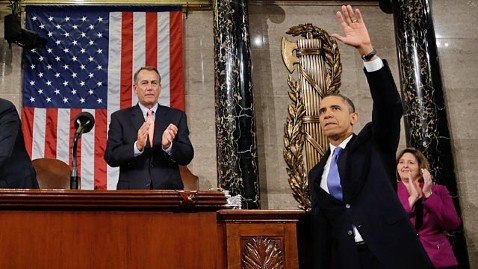Obama's Fix-It-First Plan Hard to Measure
 (Image Credit: Charles Dharapak/Pool/AP Photo)
(Image Credit: Charles Dharapak/Pool/AP Photo) National assessments of the country's roadways, bridges and waterways support President Obama's belief that we need infrastructure repairs, but with no estimates coming from the president himself, it is hard to say how much the repairs will cost and how much they'll benefit the American economy.
Obama announced in his State of the Union address Tuesday that he wanted Congress to take on a Fix-It-First program of repairing wear-and-tear on America's infrastructure, "like the nearly 70,000 structurally deficient bridges across the country."
Under the Obama administration, $31.3 billion has already gone toward infrastructure projects through the American Recovery and Reinvestment Act - better known as the stimulus package - according to the White House.
What Obama has not said is how much money should go toward this new endeavor, though he did encourage private investors to take part in the efforts. He has also avoided specifics on how many jobs his infrastructure plan would create.
A Congressional Research Service report from 2011 explains why those estimates might be tricky to pin down.
First, it's difficult to predict how much business will increase in an area once a bridge is built or a highway expanded, because that depends on other factors, such as the economic climate. The number of jobs created to complete the project is easier to calculate, but it too can vary depending on the demand for the work being done. Finally, geography seems to have a lot to do with these calculations, too.
Spending $1 billion on a construction project in 2008 in Alabama would have created 14,674 jobs, according to the report. But in New York it would have meant just 8,804.
Why such a big gap? Both earnings and industries vary largely among states.
In the case of Fix-It-First, Obama hopes to focus on meeting the needs of existing structures in the country. This raises a new complicated question: What does need mean?
Does it mean restoring a bridge to its original condition? Or does it mean expanding it to accommodate a growing population in one area?
Does it mean patching pot holes or implementing new technology to keep America's highways up-to-date?
"Because of major differences in coverage and methodology, individual needs assessments cannot be added together to provide a single estimate of future public infrastructure needs, despite the political desire to do so," the report reads.
The American Society for Civil Engineers tries to do just that every four years. It scores the state of the country's infrastructure in a report card, with the next one expected March 19.
Last month it published a report called "Failure to Act," which claims to measure the harm the country suffers when state, local and federal government neglect bridges, marine ports and waste treatment facilities. The society predicts that by 2020, the government will fall $1.092 billion short of what's needed for repairs, and that the number will climb to $4.681 trillion by 2040.
That level of neglect would damage the way Americans live and do business, according to ASCE.
"The previous studies in the 'Failure to Act' series found that underinvesting in infrastructure will result in higher costs to businesses and households as a consequence of less efficient and more costly infrastructure services," the report reads. "For example, travel times will lengthen with inefficient roadways and congested air service, and out-of-pocket expenditures to households and business costs will rise if the electricity grid or water delivery systems fail to keep up with demand."
Speaker of the House John Boehner recognized a need for infrastructure reform in his weekly news conference Thursday, saying it is a problem he has grappled with over the past few years.
Boehner hit on another question the president has yet to answer - where money for infrastructure repairs will come from.
"The president talked about infrastructure, but he didn't talk about how to pay for it," Boehner said. "You know, it's easy to go out there and be Santa Claus and talk about all the things you want to give away, but at some point somebody's got to pay the bill."